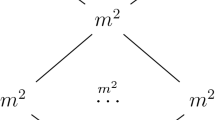Abstract
We define permutation modules and Young modules for the Brauer algebra B k (r,δ), and show that if the characteristic of the field k is neither 2 nor 3 then every permutation module is a sum of Young modules, respecting an ordering condition similar to that for symmetric groups. Moreover, we determine precisely in which cases cell module filtration multiplicities are well-defined, as done by Hemmer and Nakano for symmetric groups.
Similar content being viewed by others
References
Brauer, R.: On algebras which are connected with the semisimple continuous groups. Annals of Math. 38, 854–872 (1937)
Dipper, R., Doty, S., Hu, J.: Brauer's centralizer algebras, symplectic Schur algebras and Schur-Weyl duality. preprint (2005)
Doran, W., Hanlon, P., Wales, D.: On the semisimplicity of the Brauer algebra. J. Algebra 211, 647–685 (1999)
Erdmann, K., Sáenz, C.: On standardly stratified algebras. Comm. Algebra 31, 3429–3446 (2003)
Erdmann, K.: Young modules for symmetric groups. J. Aust. Math. Soc. 71, 201–210 (2001)
Erdmann, K.: Stratifying systems, filtration multiplicities and symmetric groups. preprint (2004)
Graham, J.J., Lehrer, G.I.: Cellular algebras. Inv. Math. 123, 1–34 (1996)
Green, J.A.: Polynominal representations of GL n , Lecture Notes in Mathematics, 830, Springer–Verlag, Berlin–New York (1980)
Hanlon, P., Wales, D.: On the decomposition of Brauer's centralizer algebra. J. Algebra 121, 409–445 (1989)
Hemmer, D., Nakano, D.: Specht filtrations for Hecke algebras of type A. J. London Math. Soc. 69, 623–638 (2004)
James, G.D.: Representation theory of symmetric groups, Lecture Notes in Mathematics 682, Springer, Berlin (1978)
James G.D., Kerber, A.: The representation theory of the symmetric group, volume 16 of Encyclopedia of Mathematics and its Applications, Addison-Wesley Publishing Co., Reading, Mass., (1981)
James, G.D., Peel, M.H.: Specht series for skew representations of symmetric groups. J. Algebra 56 , 343–364 (1979)
König, S., Xi, C.C.: A characteristic free approach to Brauer algebras. Trans. Amer. Math. Soc. 353, 1489–1505 (2001)
König, S., Xi, C.C.: On the structure of cellular algebras. Algebras and Modules II (Geiranger 1996) 365–386 CMS Conf. Proc. 24, AMS, Providence (1998)
Marcos, E., Mendoza, O., Sáenz, C.: Stratifying systems via relative simple modules. J. Algebra 280, 472–487 (2004)
Xi, C.C.: Standardly stratified algebras and cellular algebras. Math. Proc. Cambridge Philos. Soc. 133, 37–53 (2002)
Author information
Authors and Affiliations
Corresponding author
Additional information
Supported by the European Community through Marie Curie fellowship MCFI 2002-01325
Supported by EPSRC grant GR/S18151/01
Rights and permissions
About this article
Cite this article
Hartmann, R., Paget, R. Young modules and filtration multiplicities for Brauer algebras. Math. Z. 254, 333–357 (2006). https://doi.org/10.1007/s00209-006-0950-x
Received:
Accepted:
Published:
Issue Date:
DOI: https://doi.org/10.1007/s00209-006-0950-x



